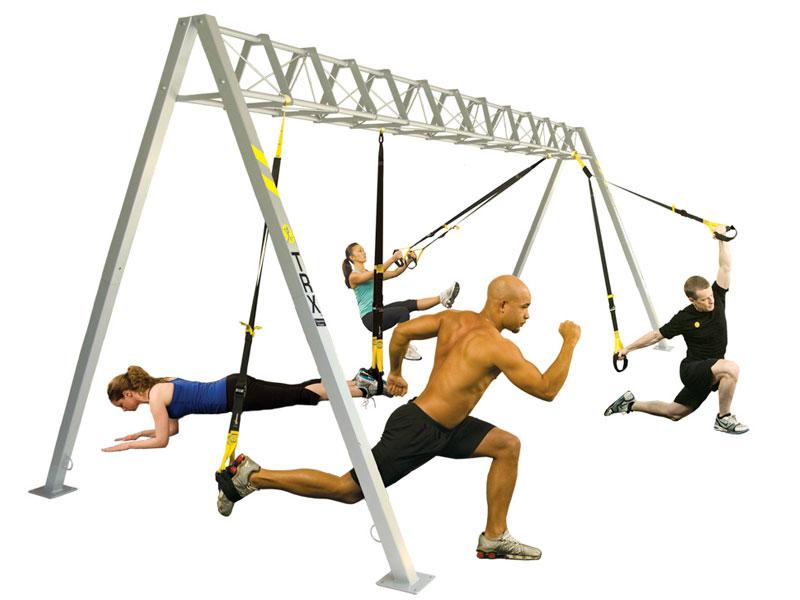What is strength training?
Strength training, sometimes referred to as resistance training, refers to a specialized method of conditioning that involves the progressive use of assorted resistive loads and a variety of training modalities intended to promote health, fitness, and sport specific performance.
That’s a mouthful. Let’s put it another way.
Strength training is using muscular force against resistance. Muscles adapt to any type of resistance.
The resistance can be a heavy object, one’s own body weight, elastic resistance from bands, or other types of machine resistance from pulleys or hydraulics. The heavy object could be a kettlebell, free weight, log, beer keg, rock, another person — anything that has mass.
Some types of resistance training




Why is strength training so important?
Most obviously, strength training makes you stronger. It does this in several ways, including:
- building muscle tissue
- improving inter- and intra-muscular coordination — in other words, the ability to coordinate your moving parts
- improving rate of force production — how quickly you can generate force to move against the resistance
- strengthening connective tissues such as tendons
It can also make your muscles bigger while creating a demand for blood delivery, engaging the cardiovascular system.
How else can strength training be useful?
Strength training:
- Preserves and enhances muscle mass
- Preserves and enhances metabolic rate
- Improves bone density
- Improves glucose tolerance and insulin sensitivity
- Lowers risk of injury
- Improves ability to engage in daily activities
- Improves balance
- Improves self-esteem
- Enhances strength and endurance
- Enhances speed, power, and agility
- Improves overall body composition
- Decreases bad cholesterol levels
- Decreases blood pressure
- Improves aerobic capacity
When muscle metabolism is altered, it can influence the development of many chronic diseases. Maintaining muscle mass with strength training can help to prevent some of the most common and increasingly rampant health conditions, including obesity and diabetes.
Who can strength train?
In the past, strength training was primarily used by athletes to enhance performance and/or increase muscle size.
However, strength training is now recognized as critical to everyone’s health and fitness — regardless of gender, age, or ability. Leading health organizations, including the ACSM and NSCA, recommend regular strength training as part of one’s fitness regimen.
With a properly constructed workout program that is tailored to individual goals and skills, anyone can strength train: men, women, children and adolescents, older people, and people with disabilities or movement limitations.
What you should know
It’s not just about the workout
Residual effects of strength training can last up to 72 hours. There seems to be a dose-response relationship between exercise intensity and observed changes in muscle mass and protein composition.
The role of SAID
The term SAID refers to specific adaptations to imposed demands. This means that our bodies adapt directly to whatever demands we give them.
- If we do particular movements, we’ll get better at those movements.
- If we do a partial range of motion, we’ll get stronger in that range of motion only. If we do a full range of motion, we’ll get stronger through that full range.
- If we use light weights and long-duration sets (i.e. high reps), we’ll gain endurance.
- If we use medium weights and medium-duration sets, we’ll gain muscle mass. We’ll also gain muscle mass using heavier weights and shorter sets, provided there’s enough overall volume to the workout.
Sets and reps
Generally, resistance training workouts are divided into sets of repetitions (aka reps).
Often the number of reps reflects the amount of weight used, or the technical complexity of the exercise. For example:
- To do a set of 15 reps requires less resistance than an all-out set of 2 reps.
- It’s easier to do a set of 15 biceps curls than a set of 15 burpees, or 15 clean and jerks.
- If you’re looking for explosiveness, you might use lower reps. If you just want to do a moderate, controlled repetition, you can use higher reps.
However, it’s also important to consider the total number of reps performed, and how heavy the weight is. (See “Volume” and “Intensity”, below.)
For example:
You could lift a weight for 3 sets of 10 reps.
Or you could lift it for 10 sets of 3 reps.
In the second case, you can probably use a lot more weight. In both cases, you end up doing 30 total reps. Which one you choose depends on your goals.
Volume
Volume refers to the total amount of reps/work within a given workout or training program. For instance:
3 set of 5 reps = 15 total reps — relatively low volume
10 sets of 10 reps = 100 total reps — relatively high volume
Intensity
Intensity in this case doesn’t mean how hard you feel you’re working, but rather how heavy the weight is relative to your maximum. High intensity means you’re lifting a heavier weight; low intensity means you’re lifting a lighter weight.
For example, if you can only do an all-out rep with 100 lbs in a given exercise, that’s your 1 rep max (1RM).
- If you use 50 lbs, that’s 50% 1RM, and low intensity
- If you use 75 lbs, that’s 75% 1RM, and medium intensity
- If you use 98 lbs, that’s 98% 1RM, and high intensity
Rest between sets
Generally, lifters rest between sets to allow ATP (muscle fuel) to regenerate. The rest length is also based on goals. The heavier the weight, and the more complex the lift, usually the longer the rest.
- When training with heavy loads for strength or power, about 3 to 5 minutes of rest between sets seems to allow for greater performance in subsequent sets.
- When the goal is improving overall body composition, the combination of moderate-intensity sets with short rest periods of 30-60 seconds might be most effective due to the metabolic cost and greater levels of growth hormone and testosterone.
- Very short rest periods of 20-40 seconds can result in better muscular endurance.
Exercise/movement types
In most cases, complex movements that involve many moving joints are best.
- For strength and power, focus on complex, multi-joint, “movement plane” exercises such as squats, deadlifts, pullups, rows, weighted jumps, etc. You can also use “functional” type exercises such as sandbag carries, sledgehammer swings, and tire flips.
- For muscle mass gain, you can use strength and power-type exercises (with medium loads) as well as targeted body part isolation exercises, such as biceps curls or triceps extensions.
- For endurance (for sport or rehab), you can use strength and power-type exercises (with lighter loads) as well as targeted body part isolation exercises.
- Many rehab-type exercises involve building endurance in specific body parts using very small movements (such as arm raises) with very light loads.
The chart below shows approximately what types of reps, sets, and other variables might help you meet specific goals.
| Goal | Exercise type | Intensity | Volume | Rep speed | Rest |
|---|---|---|---|---|---|
| Max strength | Complex, multi-joint, “movement plane” | 80-100% 1RM | Lower (1-5 reps) |
Medium-fast | Long: 3-5 min |
| Power | Complex, multi-joint, “movement plane” | 70-100% 1RM | Lower (1-5 reps) |
Fast | Long: 3-6 min |
| Muscle mass gain (hypertrophy) |
Complex, multi-joint, “movement plane” or targeted, body part isolation | 60-80% 1RM | Medium (6-12 reps) |
Medium | Medium: 30 sec to 2 min |
| Endurance (for sport or rehab) |
Complex, multi-joint, “movement plane” or targeted, body part isolation | 40-60% 1RM | Higher (12-15 reps or more) |
Medium | Short: 20 sec to 2 min |
Frequency
2 to 3.5 hours per week of strength training, divided over the course of the week, is enough for most people.
Examples include:
Monday/Wednesday/Friday for 60 minutes
Or
Monday/Tuesday/Thursday/Friday for 45 minutes
However, with sufficient variation in intensity, volume, and exercise choice, along with proper rest and recovery, more experienced trainees can do up to 5-7 hours/week.
Exercise sequence
In general, put the harder exercises before the easy exercises (e.g., multi-joint before single-joint, free weights before machines, etc). For example:
Squats before hamstring curls
Deadlifts before lower back extensions
Pullups before biceps curls
As you fatigue, it’s harder to coordinate and support the movements.
Progression
There are many different ways to make progressions.
- You can increase the weight lifted, the repetitions performed, or the sets completed.
- You can also decrease the tempo of each set to allow greater time under tension. Decreasing the rest between sets doesn’t allow your body to fully recover and is metabolically taxing.
- Even changing the biomechanics of how we do an exercise can be a method of progression (e.g., flat to incline, supinated to pronated, bent to straight, etc.).
Making it tougher
Finally, there are many ways to boost intensity with strength training. Here are some examples:
Supersets
Supersets alternate two or more exercises from set to set.
Example – 1 set of bench press; 1 set of dumbbell rows; 1 set of bench press; 1 set of dumbbell rows, etc.
Drop sets
Drop sets start with a heavier weight, then decrease the weight on subsequent sets.
Example – 10 reps with 100 pounds on squats, 8 reps with 80 pounds on squats, 6 reps with 60 pounds on squats, and so on….
Rest/pause
Rest/pause sets involve reps to fatigue, rest briefly, then do a few more reps, rest briefly, do a few more reps, and keep going until total failure.
Example – 10 reps with 100 pounds on squats, rack it, rest, 4 reps with 100 pounds, rack it, rest, 3 reps with 100 pounds
Circuits
Circuits string two or more exercises together with minimal rest in between. The lifter typically rests for a longer period after each “round”.
Example – 8 reps of pushups, 8 reps of deadlifts, 8 reps of rows, 8 reps of lunges, 30 seconds of jumping jacks, rest.
Density training
Density training involves the lifter selecting a given time limit, then trying to do as many reps as possible within that time limit.
Example – Doing pushups and pull ups for 10 – 15 minutes with minimal rest.
Negatives
Each rep has a “positive” or concentric portion (the portion where resistance is heaviest, as in the “up” part of a biceps curl), and a “negative”, or eccentric portion (the portion where one is simply resisting/controlling the resistance as it returns to the start, as in the “down” part of a biceps curl). Negative sets involve slow, controlled eccentrics, and usually an assisted concentric.
Example – Jump up to a pullup bar so your chin is above the bar; slowly lower yourself down. Here, the jump provides assistance on the “up” part.
Isometrics
Isometrics involve holding a particular static position under resistance.
Example – wall sit for 30 seconds
Planned variation
You won’t get very good results if you just wander from machine to machine, or do the same things all the time.
You also won’t get good results if you choose the wrong approach for your goals (e.g. an endurance workout if you actually want to improve your maximal strength).
Plan your workout so that:
- you know in advance what you’re doing;
- you’re not always doing the same exercises/sets/reps;
- you vary the loading; and
- you get enough rest and recovery.
Summary and recommendations
Strength training involves moving against resistance.
Anyone can strength train.
Strength train for 2 to 3.5 hours per week, distributed evenly.
Participate in a progressive warm up before strength training.
Your strength training routine should reflect your goals.
- For strength, try more heavy sets with fewer reps.
- For metabolic conditioning and endurance, try fewer moderate weight sets with higher reps.
- For hypertrophy, aim for more total reps, with moderate to heavy weights.
Think about movement choice.
- Focus on body part workouts if you are more interested in regional hypertrophy.
- Focus on complex, “movement plane” workouts if you are more interested in function, performance and strength.
Do the most taxing exercises first in your routine.
Vary your routine. The best program, as the saying goes, is the one you’re not currently doing.
Don’t forget about progression — otherwise, you probably won’t progress.
It’s virtually impossible to excel at strength training without good nutrition habits. No matter how awesome your routine is, if your nutrition is poor then you won’t make many gains.
For extra credit
Those undergoing cancer treatment, or who have previously undergone cancer treatment, may benefit from strength training.
Isometric strength training (static) can develop strength and hypertrophy.
Preparing the body for strength training with a dynamic warm-up can increase strength and performance.
Save static stretching for after strength training sessions – unless you are trying to “turn off” a certain muscle group (e.g., stretching hip flexors before squatting).
Strength training reduces the incidence of falls in older people.
References
Click here to view the information sources referenced in this article.
Learn more
Want to get in the best shape of your life, and stay that way for good? Check out the following 5-day body transformation courses.
The best part? They're totally free.
To check out the free courses, just click one of the links below.




Share